Overview
When it comes to effective search engine optimization (SEO) for eCommerce, it’s all about getting to know those search engine algorithms. Have you ever thought about how crucial keyword research is, especially when it’s focused on buyer intent? Optimizing your product pages is key, but don’t forget about implementing technical SEO best practices and leveraging content marketing strategies!
For example, let’s talk about mobile-friendliness and site speed. These factors are essential for improving visibility and driving traffic. Plus, engaging content can make all the difference in boosting your sales and keeping customers coming back for more. So, are you ready to dive into these actionable steps? Let’s explore how you can enhance your eCommerce SEO strategy together!
Introduction
The digital marketplace is changing faster than ever, and if businesses want to keep up, they need to adapt. Have you ever wondered how the right search engine optimization (SEO) strategies can help eCommerce platforms boost their visibility? By attracting more traffic, they can ultimately increase sales. But let’s be honest—navigating the ins and outs of SEO can feel overwhelming.
So, how can online retailers effectively implement these strategies to stand out in such a crowded market? In this article, we’ll explore essential steps for optimizing eCommerce sites. From grasping the basics of SEO to leveraging content marketing, we’re providing you with a roadmap for success in the ever-evolving world of online retail.
Understand the Basics of SEO for Ecommerce
To efficiently enhance your eCommerce platform, let’s discuss the basics of search engine optimization for ecommerce. It’s essential to grasp how search engines operate, the significance of keywords, and the critical role content plays in driving traffic. Here are some key concepts to focus on:
- Search Engine Algorithms: Search engines rank websites based on relevance and authority. They use complex algorithms that assess various factors to determine which sites best answer user queries. It’s fascinating how this works, isn’t it?
- Ranking Factors: Get to know the essential elements like page speed, mobile-friendliness, and overall user experience. These all significantly influence your site’s rankings. As Adam Heitzman puts it, "The old SEO playbook just isn’t working anymore," which really emphasizes the need for a modern approach.
- Organic Traffic: Attracting visitors through unpaid results is invaluable, often leading to higher conversion rates. Did you know that by 2025, voice queries could make up 50 percent of all online inquiries? This makes keyword optimization even more crucial.
- Structured Data and Schema Markup: Implementing structured data is vital for enhancing SEO and increasing visibility in search results. Well-organized material can lead to , which boost click-through rates and overall website performance.
- Regular Content Updates: Keeping your content fresh and relevant is key to maintaining authority in search rankings. Regular updates ensure that your site stays competitive and aligned with current user needs.
By mastering these foundational principles, you’ll be well-prepared to implement effective search engine optimization for ecommerce strategies tailored to your business. This will ensure long-term visibility and success in a competitive landscape. So, are you ready to dive in and make your eCommerce site shine?
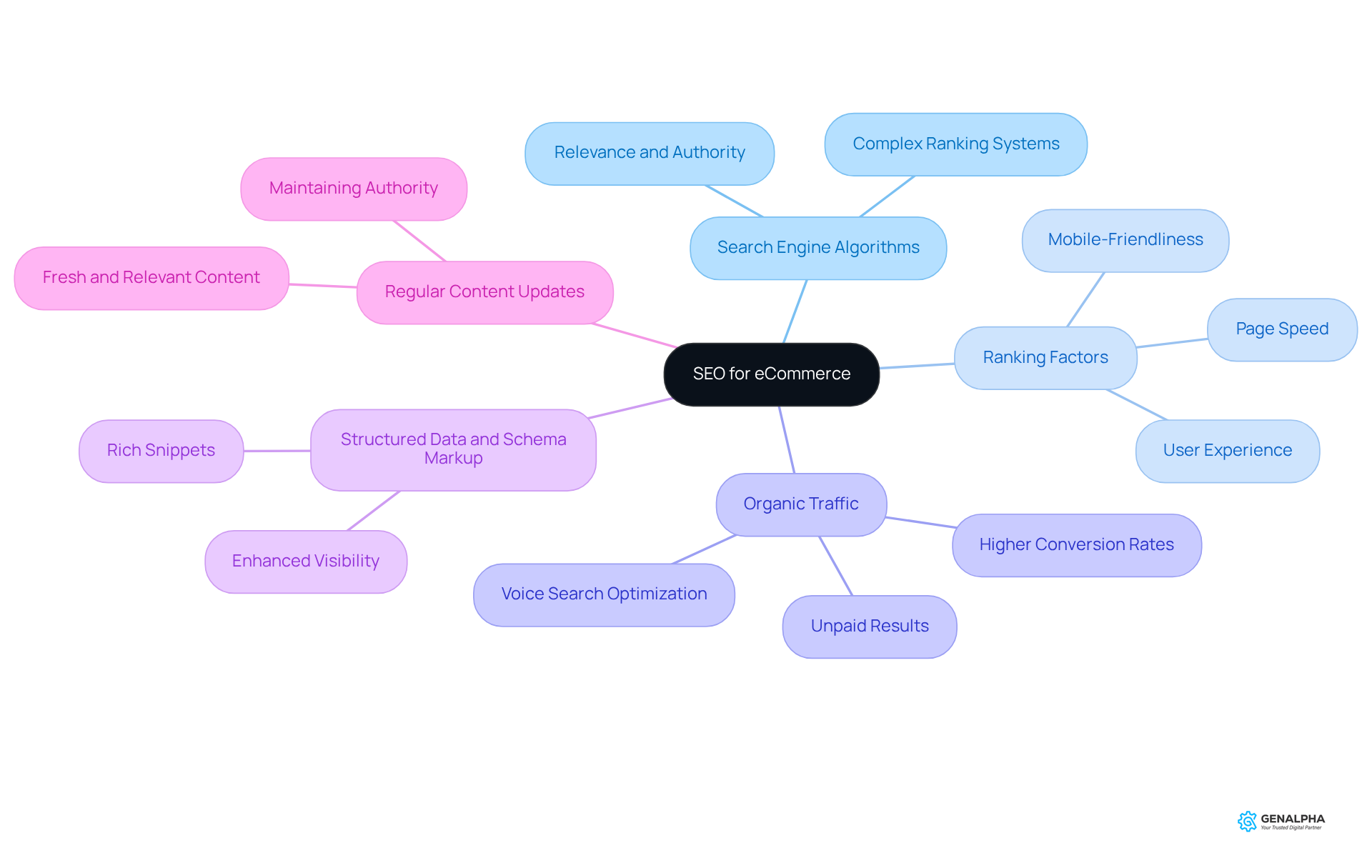
Conduct Keyword Research Focused on Buyer Intent
To conduct effective keyword research focused on buyer intent, let’s walk through some essential steps together:
- Identify Seed Keywords: Start with broad terms that relate to your products. For instance, if you’re in the outdoor equipment game, seed terms could be 'tents,' 'backpacks,' and 'sleeping bags.' Easy enough, right?
- Utilize Keyword Research Tools: Dive into tools like Google Keyword Planner, Ahrefs, or SEMrush. These can help you uncover associated terms, check out their search volume, and analyze competition levels. You’ll find here, which make up 70% of all search traffic and often lead to higher click-through rates. Fun fact: long-tail phrases with four words snag the highest click-through rates at 31.8%!
- Prioritize Buyer Intent: Zero in on terms that show strong purchasing intent, like 'buy tents online' or 'best hiking backpacks.' Research shows that focusing on buyer intent can significantly enhance your conversion rates, making search engine optimization for ecommerce essential for your success.
- Analyze Competitors: Take a peek at the terms your competitors are ranking for. This can reveal gaps or opportunities in your own strategy. You might uncover some valuable terms you hadn’t considered, which can help you refine your approach.
- Compile a Targeted Term List: Put together a solid list of high-potential terms to use in your content and product pages. Mix short-tail and long-tail keywords to capture a broad audience while also targeting specific buyer intents. It’s all about balance!
- Incorporate AI Tools: Think about using AI-powered keyword research tools to streamline your process and spot emerging trends. As AI continues to shape SEO strategies, these tools can really amp up your keyword research efficiency.
- Optimize Visual Content: Since 62% of Millennials prefer engaging with visual content, make sure your keyword strategies also optimize visual elements like images and videos. This can really enhance user engagement.
By focusing on buyer intent and integrating search engine optimization for ecommerce into your strategy, you can attract more qualified traffic to your eCommerce site, resulting in increased sales and happier customers. So, are you ready to get started?
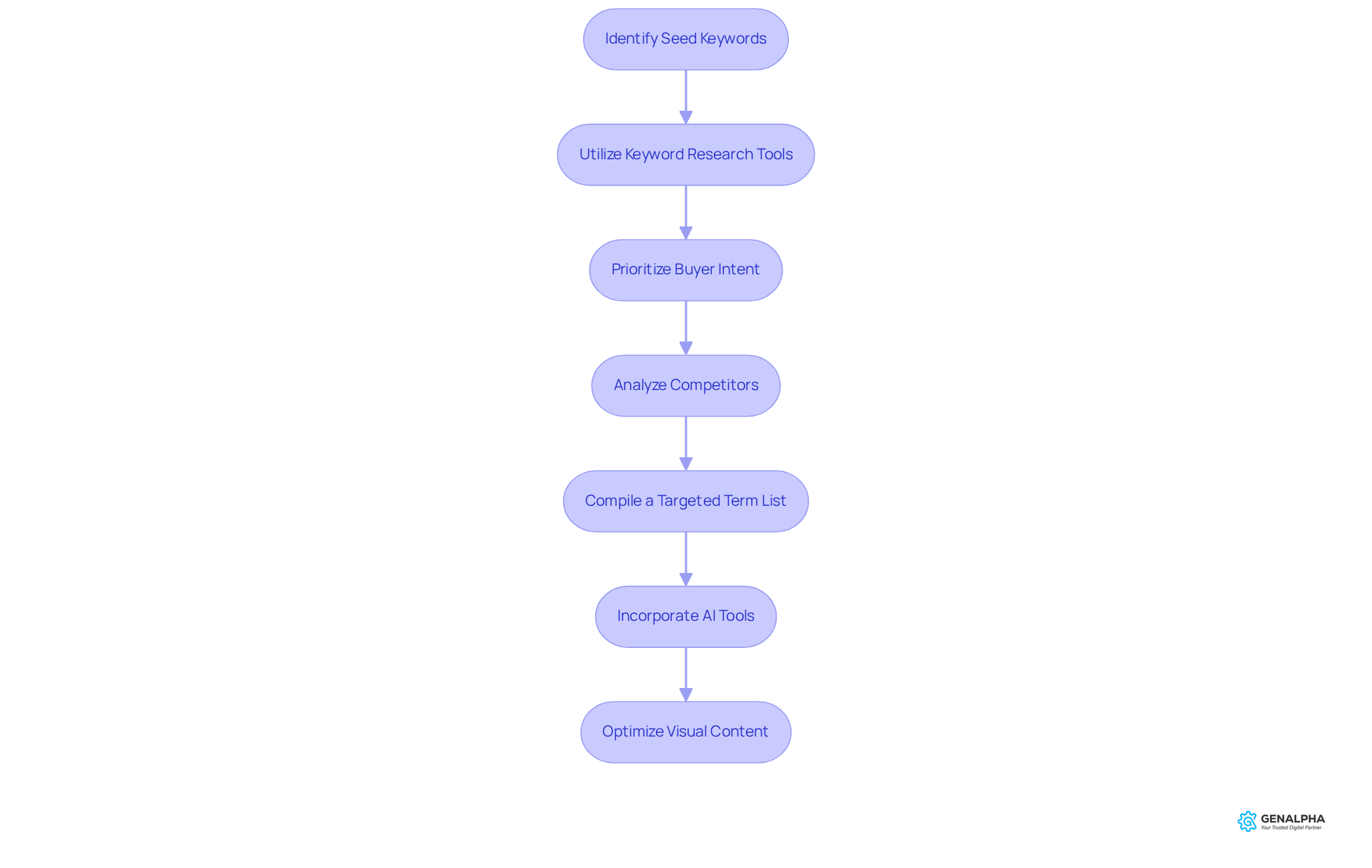
Optimize Product Pages for Enhanced Visibility
To really make your product pages shine, let’s dive into some strategies that can help you out:
- Use Descriptive Titles: Think about this—each product title should not only include the right terms but also give a clear picture of what the item is. When titles are straightforward and to the point, they can really . After all, users want to feel confident that they’ve found exactly what they’re looking for.
- Write Compelling Descriptions: Here’s where you can get creative! Craft unique and informative product descriptions that highlight features, benefits, and specifications. Research shows that detailed descriptions of 300-500 words can really amp up your SEO performance and help shoppers make smart choices. Just remember to weave in those important terms naturally to align with what users are searching for.
- Optimize Images: Let’s not forget about visuals! High-quality images are key for engaging users and increasing conversion rates. Make sure your images load quickly and include informative alt text with relevant keywords. Studies indicate that well-optimized visuals can lead to higher conversion rates, so it’s worth the effort!
- Implement Structured Data: Ever heard of schema markup? It’s a great way to give search engines the essential product details they need, like price, availability, and reviews. This can boost your product's visibility in search results, potentially leading to rich snippets that attract more clicks from interested buyers.
- Encourage Customer Reviews: Positive reviews are gold! They not only build credibility but also play a role in SEO. Encourage your customers to share their thoughts on product pages. Just a tip—only display reviews when there are 10 or more verified ratings to enhance trustworthiness. These reviews can really sway purchasing decisions and improve the overall user experience.
By embracing these optimization techniques—like using structured data and focusing on customer reviews—you can significantly enhance the visibility of your product pages through search engine optimization for ecommerce. This means more traffic and, ultimately, more sales. So, are you ready to give it a go?
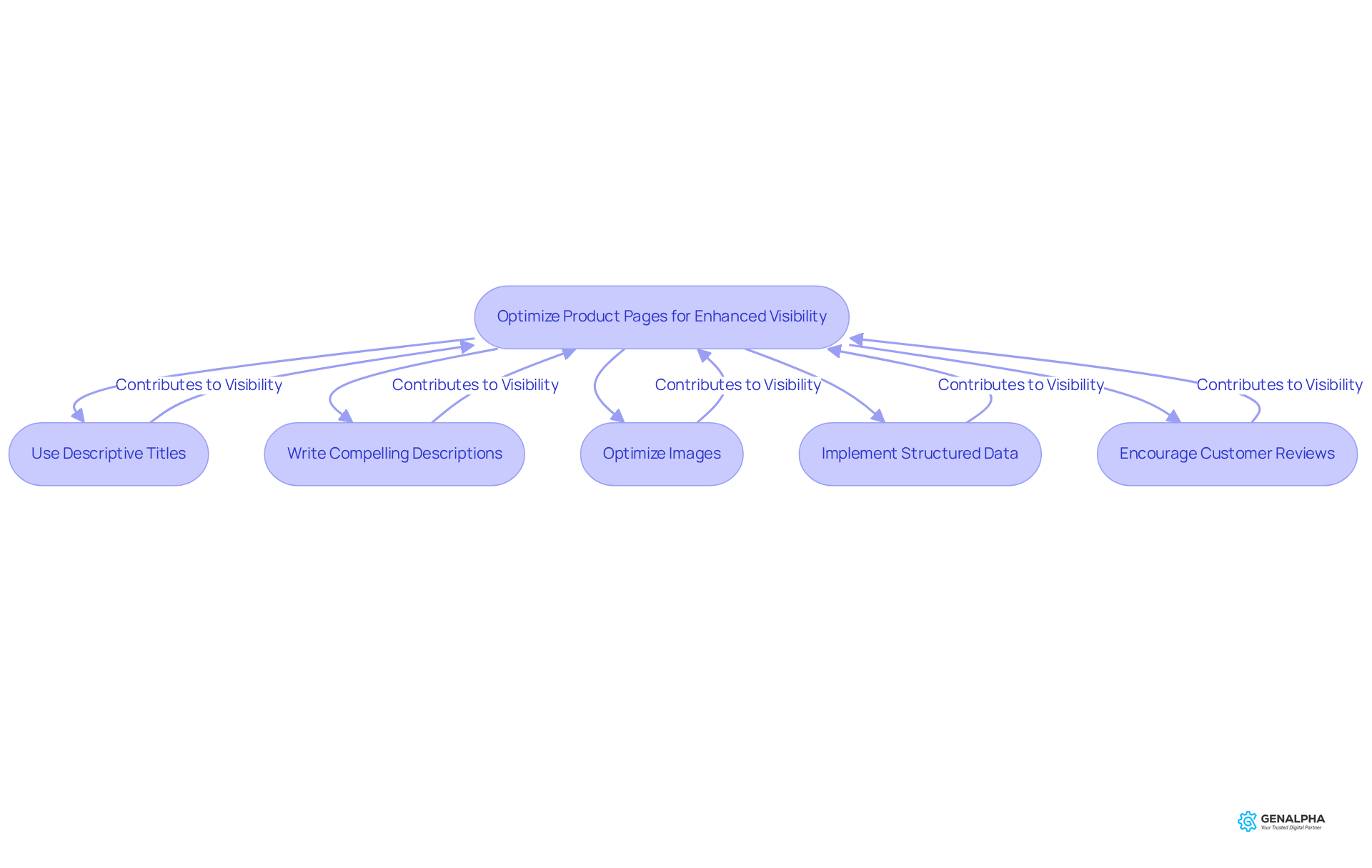
Implement Technical SEO Best Practices
To implement technical SEO best practices, let’s break it down into some easy steps you can take:
- Ensure Mobile-Friendliness: Think about how often you browse on your phone. With over 60% of traffic coming from mobile devices, making sure your platform is is crucial. As Neil Patel wisely points out, 'A mobile-optimized platform is essential for retaining visitors and enhancing user experience.' So, responsive design is a must!
- Improve Site Speed: Nobody likes waiting for a page to load, right? Optimize your images, enable browser caching, and minimize your code to speed things up. Did you know that even a one-second delay can lead to a 7% drop in conversions? Prioritizing loading speed is key to keeping potential customers engaged.
- Create an XML Sitemap: Ever wonder how search engines find your content? Submitting an XML sitemap helps them understand your website’s structure and index your pages more effectively. This ensures all your content is discoverable, which is vital for boosting your visibility.
- Utilize HTTPS: Security is a big deal these days. By securing your platform with HTTPS, you not only protect user data but also build trust. Google loves secure sites and ranks them higher, making this an essential step for any eCommerce business.
- Fix Crawl Errors: Have you checked for crawl errors lately? Regularly using tools like Google Search Console can help you find and fix these issues. Ensuring that search engines can access all your pages is essential for maintaining your SEO health. Tackling these problems can really improve your platform's performance.
By focusing on these technical elements, you’re establishing a solid foundation for search engine optimization for ecommerce on your platform. This will ultimately lead to better visibility and happier users. So, what are you waiting for? Let’s get started!
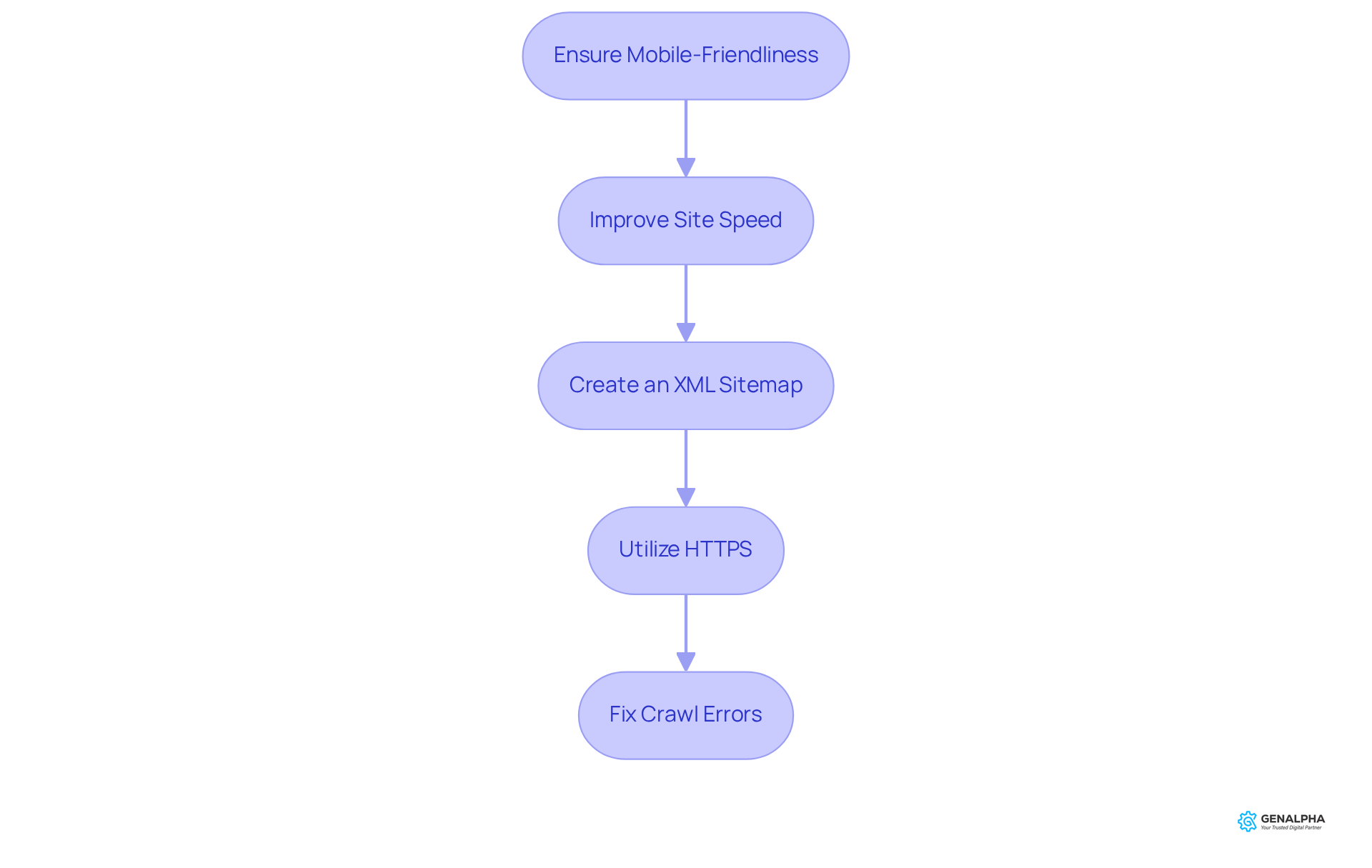
Leverage Content Marketing to Drive Traffic
To leverage content marketing effectively, let’s explore some friendly strategies together:
- Create a Blog: Think about setting up a blog on your eCommerce platform where you can share useful info related to your products—like buying guides, tips, and industry updates. Educational blog posts are particularly effective; they’re actually twice as likely to be shared on social media, boosting your visibility and engagement. As Neal Schaffer puts it, 'Content marketing is essential for ecommerce businesses to improve their search engine optimization for ecommerce, attracting, engaging, and converting customers.'
- Utilize Social Media: Don’t forget to actively share your blog material across social media platforms! This helps you reach a broader audience and drive traffic back to your site. With over 5.2 billion social media users globally, tapping into these channels can really . In fact, 93% of marketers say they’ve seen increased business traffic thanks to social media marketing efforts.
- Incorporate Video Content: Have you thought about developing product demonstration videos or tutorials? They’re a fantastic way to engage users and add extra value. Video content not only supports the customer journey but also helps potential customers visualize your products in action, enhancing their perception of your brand.
- Enhance material for search engine optimization for ecommerce: Ensure your blog and other materials are optimized for relevant keywords to improve your visibility in search results. Effective SEO practices, like placing keywords in titles and headings, can lead to higher search rankings and greater organic traffic. Remember, effective marketing generates valuable, relevant info that drives engagement and conversion rates.
- Engage with Your Audience: Let’s foster a sense of community by encouraging comments and feedback on your material! Engaging with your audience builds relationships and increases the chance of repeat visits. Did you know that customers who interact with brands on social media tend to spend 35-40% more? Keep an eye on engagement metrics like social shares, comments, and likes to measure how well your strategies are working.
By implementing these content marketing strategies, you can effectively drive traffic to your eCommerce site and enhance your search engine optimization for ecommerce efforts. This will ultimately lead to improved customer retention and increased sales. So, what are you waiting for? Let’s get started!
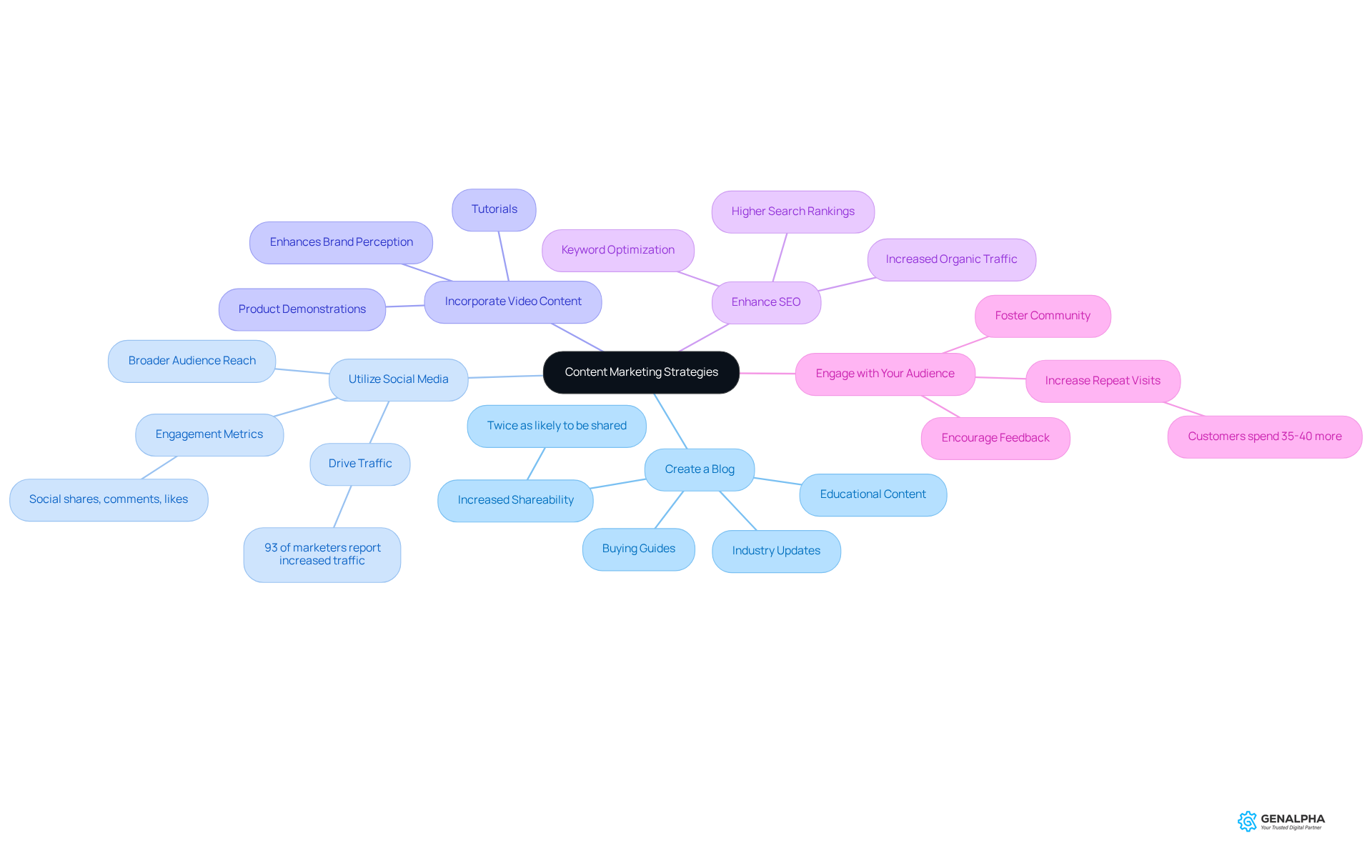
Conclusion
Mastering effective search engine optimization (SEO) for eCommerce is essential for businesses that want to thrive in today’s competitive digital landscape. Have you ever wondered how some online stores seem to pop up at the top of search results? By grasping the core principles of SEO—like keyword research, product page optimization, technical practices, and content marketing—eCommerce platforms can significantly boost their visibility and attract more qualified traffic.
Throughout this article, we’ve highlighted key strategies that can really make a difference. For instance:
- Focusing on buyer intent during keyword research can help you understand what your customers are really looking for.
- Optimizing product pages with descriptive titles and engaging content is another game-changer.
- Implementing technical SEO best practices, such as ensuring mobile-friendliness and improving site speed, is crucial.
- Leveraging content marketing to drive traffic is also essential.
Each of these components plays a vital role in not only improving search engine rankings but also in increasing conversion rates and fostering customer loyalty.
So, what’s the takeaway? Embracing these SEO strategies isn’t just about keeping up with trends; it’s about positioning your eCommerce business for long-term success. As the digital marketplace continues to evolve, staying informed and adaptable will empower you to meet consumer needs effectively. Why wait? Start implementing these tactics today to ensure your eCommerce site not only shines in search results but also delivers an exceptional user experience that turns visitors into loyal customers.
Frequently Asked Questions
What is the importance of understanding SEO for eCommerce?
Understanding SEO for eCommerce is crucial as it helps enhance your platform's visibility, drives organic traffic, and ultimately leads to higher conversion rates.
How do search engine algorithms work?
Search engine algorithms rank websites based on relevance and authority by assessing various factors to determine which sites best answer user queries.
What are some key ranking factors for SEO?
Key ranking factors include page speed, mobile-friendliness, and overall user experience, all of which significantly influence your site's rankings.
What is organic traffic and why is it valuable?
Organic traffic refers to visitors who arrive at your site through unpaid search results, which often leads to higher conversion rates.
What role does keyword optimization play in SEO?
Keyword optimization is essential for attracting visitors, especially with the rise of voice queries, which are expected to make up 50 percent of online inquiries by 2025.
What is structured data and schema markup?
Structured data and schema markup help enhance SEO and increase visibility in search results, potentially leading to rich snippets that boost click-through rates.
Why are regular content updates important for SEO?
Regular content updates keep your site fresh and relevant, helping maintain authority in search rankings and ensuring competitiveness.
What are seed keywords and how do I identify them?
Seed keywords are broad terms related to your products, such as 'tents' or 'backpacks.' They serve as the starting point for keyword research.
Which tools can be used for keyword research?
Tools like Google Keyword Planner, Ahrefs, and SEMrush can help uncover associated terms, search volumes, and competition levels.
What is the significance of buyer intent in keyword research?
Focusing on terms that show strong purchasing intent, like 'buy tents online,' can significantly enhance conversion rates.
How can I analyze competitors for keyword opportunities?
By examining the terms your competitors are ranking for, you can identify gaps or opportunities in your own keyword strategy.
What should be included in a targeted term list?
A targeted term list should include a mix of high-potential short-tail and long-tail keywords to capture a broad audience and specific buyer intents.
How can AI tools assist in keyword research?
AI-powered keyword research tools can streamline the process and help identify emerging trends, enhancing research efficiency.
Why is it important to optimize visual content for SEO?
Optimizing visual content is important because 62% of Millennials prefer engaging with visual elements, which can enhance user engagement.




